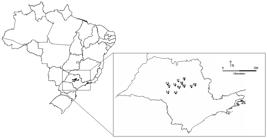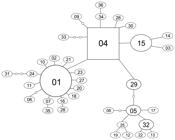Abstract
Green lacewings are insects with great potential to be use in the biological control of agricultural pests, but relatively few studies have attempted to understand the genetic structure of these agents, especially those of predatory insects. The purpose of this study was to characterize genetically populations of C. externa using sequences of subunit I of the cytochrome oxidase, a mitochondrial gene, and examine the population structure of this species in sampled areas in São Paulo state. The results indicate high genetic diversity but no genetic structure, detected by AMOVA analysis, and high levels of haplotype sharing in the network. These genetic patterns could be a consequence of environmental homogeneity provided by agroecosystem (citrus orchard), allowing gene flow among populations. Probably there is a unique population in the area sampled that could be used as a population (genetic) source for mass-reared and posterior release in these farms.
Keywords:
COI gene; green lacewings; mitochondrial DNA; population structure

 Thumbnail
Thumbnail
 Thumbnail
Thumbnail

